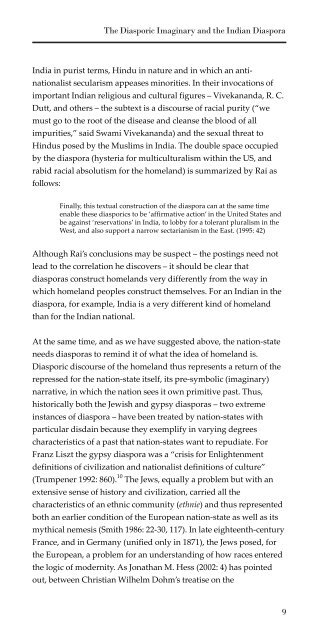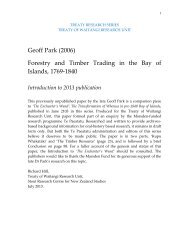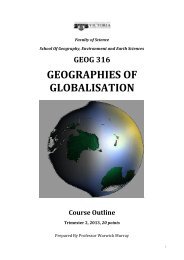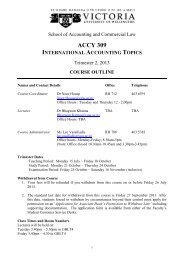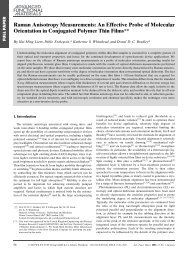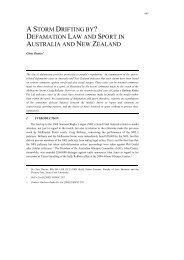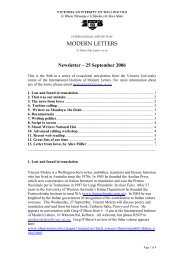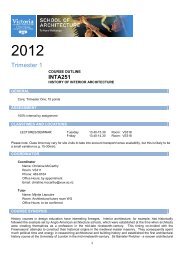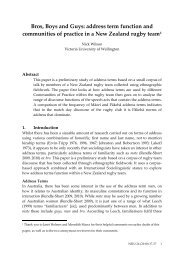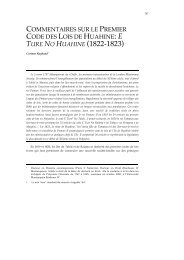The Diasporic Imaginary and the Indian Diaspora - Victoria ...
The Diasporic Imaginary and the Indian Diaspora - Victoria ...
The Diasporic Imaginary and the Indian Diaspora - Victoria ...
You also want an ePaper? Increase the reach of your titles
YUMPU automatically turns print PDFs into web optimized ePapers that Google loves.
<strong>The</strong> <strong>Diasporic</strong> <strong>Imaginary</strong> <strong>and</strong> <strong>the</strong> <strong>Indian</strong> <strong>Diaspora</strong><br />
India in purist terms, Hindu in nature <strong>and</strong> in which an antinationalist<br />
secularism appeases minorities. In <strong>the</strong>ir invocations of<br />
important <strong>Indian</strong> religious <strong>and</strong> cultural figures – Vivekan<strong>and</strong>a, R. C.<br />
Dutt, <strong>and</strong> o<strong>the</strong>rs – <strong>the</strong> subtext is a discourse of racial purity (“we<br />
must go to <strong>the</strong> root of <strong>the</strong> disease <strong>and</strong> cleanse <strong>the</strong> blood of all<br />
impurities,” said Swami Vivekan<strong>and</strong>a) <strong>and</strong> <strong>the</strong> sexual threat to<br />
Hindus posed by <strong>the</strong> Muslims in India. <strong>The</strong> double space occupied<br />
by <strong>the</strong> diaspora (hysteria for multiculturalism within <strong>the</strong> US, <strong>and</strong><br />
rabid racial absolutism for <strong>the</strong> homel<strong>and</strong>) is summarized by Rai as<br />
follows:<br />
Finally, this textual construction of <strong>the</strong> diaspora can at <strong>the</strong> same time<br />
enable <strong>the</strong>se diasporics to be ‘affirmative action’ in <strong>the</strong> United States <strong>and</strong><br />
be against ‘reservations’ in India, to lobby for a tolerant pluralism in <strong>the</strong><br />
West, <strong>and</strong> also support a narrow sectarianism in <strong>the</strong> East. (1995: 42)<br />
Although Rai’s conclusions may be suspect – <strong>the</strong> postings need not<br />
lead to <strong>the</strong> correlation he discovers – it should be clear that<br />
diasporas construct homel<strong>and</strong>s very differently from <strong>the</strong> way in<br />
which homel<strong>and</strong> peoples construct <strong>the</strong>mselves. For an <strong>Indian</strong> in <strong>the</strong><br />
diaspora, for example, India is a very different kind of homel<strong>and</strong><br />
than for <strong>the</strong> <strong>Indian</strong> national.<br />
At <strong>the</strong> same time, <strong>and</strong> as we have suggested above, <strong>the</strong> nation-state<br />
needs diasporas to remind it of what <strong>the</strong> idea of homel<strong>and</strong> is.<br />
<strong>Diasporic</strong> discourse of <strong>the</strong> homel<strong>and</strong> thus represents a return of <strong>the</strong><br />
repressed for <strong>the</strong> nation-state itself, its pre-symbolic (imaginary)<br />
narrative, in which <strong>the</strong> nation sees it own primitive past. Thus,<br />
historically both <strong>the</strong> Jewish <strong>and</strong> gypsy diasporas – two extreme<br />
instances of diaspora – have been treated by nation-states with<br />
particular disdain because <strong>the</strong>y exemplify in varying degrees<br />
characteristics of a past that nation-states want to repudiate. For<br />
Franz Liszt <strong>the</strong> gypsy diaspora was a “crisis for Enlightenment<br />
definitions of civilization <strong>and</strong> nationalist definitions of culture”<br />
(Trumpener 1992: 860). 10 <strong>The</strong> Jews, equally a problem but with an<br />
extensive sense of history <strong>and</strong> civilization, carried all <strong>the</strong><br />
characteristics of an ethnic community (ethnie) <strong>and</strong> thus represented<br />
both an earlier condition of <strong>the</strong> European nation-state as well as its<br />
mythical nemesis (Smith 1986: 22-30, 117). In late eighteenth-century<br />
France, <strong>and</strong> in Germany (unified only in 1871), <strong>the</strong> Jews posed, for<br />
<strong>the</strong> European, a problem for an underst<strong>and</strong>ing of how races entered<br />
<strong>the</strong> logic of modernity. As Jonathan M. Hess (2002: 4) has pointed<br />
out, between Christian Wilhelm Dohm’s treatise on <strong>the</strong><br />
9


